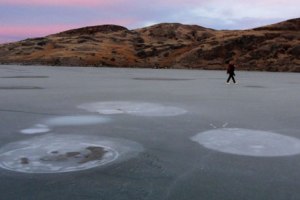Lakes across Alaska and Siberia have started to bubble with methane, and the release of this highly potent greenhouse gas has scientists worried.
Last month NASA released footage showing the bubbling Arctic lakes, which are the result of a little known phenomenon called “abrupt thawing.” It occurs when the permafrost—ground that has been frozen for potentially thousands of years—thaws faster than expected.
Scientists have long known that the thawing permafrost has the potential to release large amounts of methane into the atmosphere. As the organic matter that has been locked up in the ground defrosts it decomposes, releasing carbon and methane (a hydrocarbon) in the process.
If all this was released into the atmosphere, the impact on climate change would be huge. In total there is about 1,500 billion tons of carbon locked up in the permafrost—almost double the amount of carbon in the atmosphere right now.
Thawing permafrost has currently been causing problems across the Arctic. In Siberia, huge craters have opened up across the tundra. While not confirmed, it is believed that as the permafrost thaws, pockets of methane are formed. When the pressure gets too high, these pockets explode.
Methane was also thought to be causing the ground to wobble—video released in 2016 showed patches of grassland bobbing up and down when researchers stood on it.
As the thawing continues, it will eventually cause major problems for the towns and cities located in these northern regions—as the ground becomes softer, roads warp and buildings start sinking into the ground.
In a NASA-funded study published in Nature Communications, scientists have now discovered a source of methane that has not been accounted for in climate models—methane coming from “thermokarst” lakes.
These lakes form when the permafrost thaws at a faster rate and deeper into the ground than normal. The thawing creates a depression, which then fills with rain water, ice and snow melt. The water then speeds up the rate of the permafrost thaw at the shores of the lake.
The process—abrupt thawing—could speed up the release of methane into the atmosphere.
“Within decades you can get very deep thaw holes, meters to tens of meters of vertical thaw,” Katey Walter Anthony, from the University of Alaska Fairbanks, said in a statement. “So you’re flash thawing the permafrost under these lakes. And we have very easily measured ancient greenhouse gases coming out.”
Researchers used measurements from 11 thermokarst lakes and computer models to show that abrupt thawing will result in more than double previous estimates of the warming from the thawing permafrost. They found methane bubbling at 72 locations within these lakes, measuring the amount of gas being released by the permafrost beneath the water. They then compared the release to that seen at normal Arctic lakes, where gradual permafrost thaw is taking place.
Findings showed the abrupt thawing at the thermokarst lakes was significant in terms of methane release—and the researchers noted that this source of greenhouse gases was not accounted for properly in the climate change scenarios set out by the Intergovernmental Panel on Climate Change (IPCC). Essentially, even if we reduce anthropogenic greenhouse gas emissions, the methane release from these lakes will still occur.
“The mechanism of abrupt thaw and thermokarst lake formation matters a lot for the permafrost-carbon feedback this century,” Walter Anthony said. “We don’t have to wait 200 or 300 years to get these large releases of permafrost carbon.
“Within my lifetime, my children’s lifetime, it should be ramping up. It’s already happening but it’s not happening at a really fast rate right now, but within a few decades, it should peak.”
As a result, she is calling for this source of methane to be included in climate models to get a more accurate picture of future climate change.


